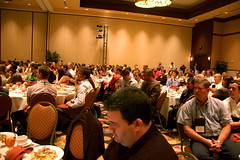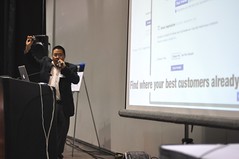In part 1, written last summer, I encouraged you to use the nearly unlimited power of social media to build the kind of inspirational network you need as a foundation for success. We tend to become the company we keep, so why not use social media to find the examples of success and happiness that you want more of in your life?
 The flip side of the coin is that we tend to become the company we keep. If we surround ourselves with bitter, angry, uninspiring people who do nothing but urinate into our mental pool, we go that route too – and unlike positive, inspiring people, it doesn’t take much. As Tony Robbins once quipped, you don’t need to drink a gallon of poison to have an effect – just a little is more than enough.
The flip side of the coin is that we tend to become the company we keep. If we surround ourselves with bitter, angry, uninspiring people who do nothing but urinate into our mental pool, we go that route too – and unlike positive, inspiring people, it doesn’t take much. As Tony Robbins once quipped, you don’t need to drink a gallon of poison to have an effect – just a little is more than enough.
Go open Twitter or Facebook right now. Take a look at the people who put stuff into your head ever fleetingly, 140 characters at a time. Is their stuff good for you or bad for you? When you read what they have to say, do you feel better or worse? When you hear them speak, do you feel energized and excited or cynical and dismissive? Do they use their social media channels to inspire with stories about people in their lives who have helped them or whine about the poor service someone gave them?
It’s easy to tolerate negativity and incredibly poisonous to do so. Sometimes you feel socially obligated to if it’s a close friend or someone you care about. Here’s a nifty, somewhat sneaky antidote to those people. First, create a network with a lot of people in it. Tons. Follow everyone that you can that’s inspiring to you. This increases the probability that whenever you do open a social network, the chances are good that someone will be saying something that brings some positive energy to your day. Next, to the extent that a social network permits you to, create a private list of positive, powerful, inspiring friends, folks who seem to always have something good to bring to the table. Finally, prune out those friends who don’t necessarily bring good cheer to you from that private, secret, quiet list of those that do, so that you don’t have to hurt someone’s feelings by cutting them out of your network, but you don’t have to put their baggage in your taxi either.
You have enough negative forces in your life without voluntarily adding more to it with social media. Unlike a workplace or home, you have complete freedom to choose who you listen to in social media, to choose who you allow to influence you.
Choose wisely for you become the company you keep.
Did you enjoy this blog post? If so, please subscribe right now!
Get this and other great articles from the source at www.ChristopherSPenn.com! Want to take your conference or event to the next level? Book me to speak and get the same quality information on stage as you do on this blog.



 Where the martial arts (good ones, anyway) differ is the continued emphasis on the basics. We learn the basics but constantly revisit them to refine our understanding and improve them. As our basics get stronger, the “advanced” material (which is comprised of basics strategically arranged and put together) improve as well. Because advanced material relies on the basics, if we stop refining them, our advanced skills and techniques suffer as well.
Where the martial arts (good ones, anyway) differ is the continued emphasis on the basics. We learn the basics but constantly revisit them to refine our understanding and improve them. As our basics get stronger, the “advanced” material (which is comprised of basics strategically arranged and put together) improve as well. Because advanced material relies on the basics, if we stop refining them, our advanced skills and techniques suffer as well.
 … until the first thing out of their mouth at the proposal stage is a price objection. “It’s too expensive” or a variant of that phrase. Rather than cutting your prices immediately (which is the most common tactic for a rookie salesperson), get specific.
… until the first thing out of their mouth at the proposal stage is a price objection. “It’s too expensive” or a variant of that phrase. Rather than cutting your prices immediately (which is the most common tactic for a rookie salesperson), get specific. I read with great interest about another company forsaking email marketing – this time, ice cream maker Ben & Jerry’s. Good. Thank you very much!
I read with great interest about another company forsaking email marketing – this time, ice cream maker Ben & Jerry’s. Good. Thank you very much! I’ve been shopping around the past few days for a terrific lead automation system for the day job, looking at all of the different vendors out there. One thread that’s been common among all of the comparison discussions on LinkedIn, on blogs, etc. that baffles me is this argument:
I’ve been shopping around the past few days for a terrific lead automation system for the day job, looking at all of the different vendors out there. One thread that’s been common among all of the comparison discussions on LinkedIn, on blogs, etc. that baffles me is this argument: I’ll be doing a webinar on July 23 at 2 PM Eastern on 21st century email marketing, put on by my employer,
I’ll be doing a webinar on July 23 at 2 PM Eastern on 21st century email marketing, put on by my employer,  One of my favorite learning and teaching metaphors comes by way of both the martial arts and
One of my favorite learning and teaching metaphors comes by way of both the martial arts and 

